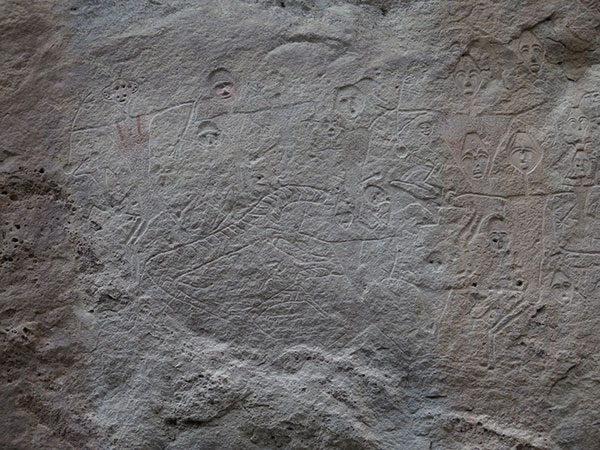
Rock art. (Photo:China Daily/Cui Jia)
Pre-historic rock art widely existed in what are now 120 countries on five continents as the information carrier of different primitive tribes bearing different information.
Experts say that most of the rock art discovered in China is in Xinjiang because its favorable natural environment has always been suitable for sustaining human communities. More than 1,226 rock art sites in 29 province and regions have been found throughout China, and most can be dated back to the Upper Paleolithic period.
In China rock art found in the north and south have completely different styles and themes even when they are from the same age. The ancient northerners normally carved in rock images of animals and scenes of herding while those in the south used red paint depict hunting as well as dancing during religious ceremonies.
Of course, because such rock art is exposed to the elements for so long, it is susceptible to deterioration, Wang Jianping says.
"Many of them have deteriorated to the point of disappearing, and the messages of our ancestors have been lost forever."
Also, because of their remote locations and difficulties in evaluating their true historical value, about 75 percent of rock art in China does not enjoy the protection of the authorities responsible for such relics, he says.
"Dating and interpreting rock art are huge challenges for researchers worldwide. The authorities need to start treating these relics as important parts of the country's heritage."
Ancient rock art continues to be found around China, and the best known sites such as Kangjia Shimenzi have been turned into tourist attractions. In the case of Kangjia Shimenzi that has entailed building steps so visitors can get a close view of the human figures on the cliff. As much as experts welcome the public interest in such rock art, they also worry that growing numbers of tourists put preservation efforts at risk.
The discovery of rock art in Habahe county in Altay prefecture in northern Xinjiang, which includes a pictograph said to resemble an aircraft, has attracted widespread media attention and a growing number of tourists to rock art sites, says Liu Cheng, a professor of archeology at Northwestern University in Xi'an, Shaanxi province.
Liu, who first traveled to Habahe to study the pictographs six years ago, cites one practical example of how increasing numbers of tourists are already proving to be detrimental to preservation efforts.
"Many people are driving a long way to camp near the rock arts sites, and they leave garbage behind when they leave."
His team has found beer bottles and other garbage even inside the rock art site, he says.
"There is evidence, too, that the pictographs have been tainted by beer. That is making our work more urgent."
The most important work for his team is to document all the pictographs for research before they suffer from human intervention, he says.
Previously many local herders regarded the caves where the rock art is preserved as sacred, he says, and that is why they had remained free of human intervention for thousands of years.
It is important that local authorities ease up with their plans to develop the sites into tourist attractions, he says.
Because many rock art sites are highly susceptible to any form of human intervention, protective measures need to be put into place before tourism is developed, he says.
Wang Jianping says: "Rock art is not just art but something that paints a picture for us of how our ancestors thought before writing appeared. People need to realize that understanding our past can help human beings look into the future."


















































